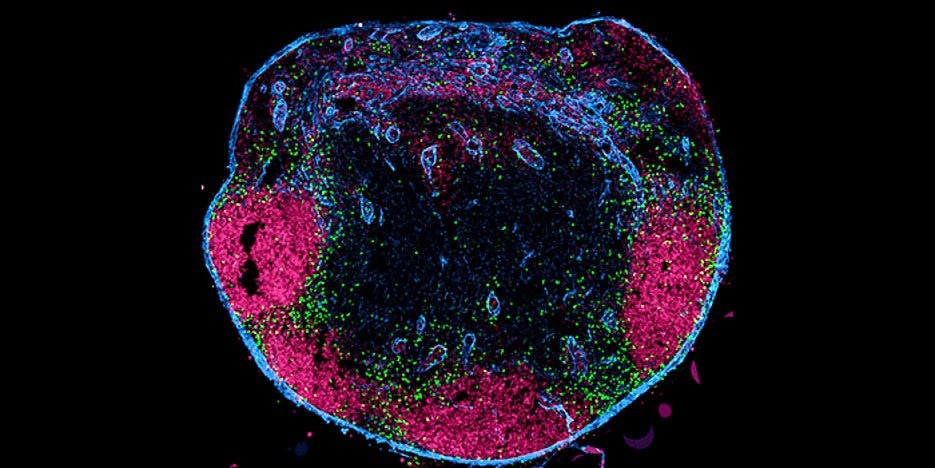There are 600 to 800 lymph nodes in the human body, which are specialized organs that cause immunological reactions. Lymph nodes are connected to the various organs by lymph vessels, allowing them to receive information about infections in the body.
 Cross-section through a lymph node. The unconventional T cells (green), which have migrated from the tissue via the lymphatic channels, are located in the marginal sinus and in the interfollicular zone. Follicular B cells are shown in magenta, the lymph node capsule and lymphatic vessels in blue. Image Caption: Konrad Knöpper/Universität Würzburg.
Cross-section through a lymph node. The unconventional T cells (green), which have migrated from the tissue via the lymphatic channels, are located in the marginal sinus and in the interfollicular zone. Follicular B cells are shown in magenta, the lymph node capsule and lymphatic vessels in blue. Image Caption: Konrad Knöpper/Universität Würzburg.
The lymph vessels carry fluids and certain immune cells to the lymph nodes from the organs. Dendritic cells, a type of immune cell, transport information from the organs to the lymph nodes and transmit it to more immune cells there.
Now it is evident that this significant information flow does not only originate from dendritic cells. Researchers from Julius-Maximilians-Universität (JMU) Würzburg in Bavaria, Germany, under the direction of immunologist Professor Wolfgang Kastenmüller, have found that so-called unconventional T cells also continuously migrate from the tissue into the lymph nodes and affect the immune responses there.
This finding has implications for both cancer immunotherapies and vaccination regimens.
Different subtypes of unconventional T cells
Each tissue in our body has different subtypes of unconventional T cells. Since these cells each migrate to the nearest lymph node, the individual lymph nodes also differ in the composition of the T cells. And that has a direct effect on the immune responses of the individual lymph nodes.”
Wolfgang Kastenmüller, Chair, Systems Immunology, Julius-Maximilians-Universität Würzburg
A lymph node that has learned about an infection in the lungs, for instance, will respond differently to the infection than a lymph node that learns about the infection via the colon or the skin.
Taking advantage of the differences between lymph nodes
For instance, vaccination is given intramuscularly or topically always targets lymph nodes close to the surface. However, if additional lymph nodes are nearby when the vaccine is given, it might be far more effective. The immunotherapies used to treat cancer should also be taken into account.
That is why we want to investigate next whether we can use the difference in lymph nodes to make vaccinations more efficient or to improve immunotherapies against cancer.”
Wolfgang Kastenmüller, Chair, Systems Immunology, Julius-Maximilians-Universität Würzburg
If the variations in the lymph nodes can be actively changed is another intriguing subject. And it needs to be made clear what relevance the new discoveries have for the emergence of autoimmune disorders and cancer.
Source:
Journal reference:
Ataide, M. A., et al. (2022) Lymphatic migration of unconventional T cells promotes site-specific immunity in distinct lymph nodes. Immunity. doi.org/10.1016/j.immuni.2022.07.019.